Bolshoi Theatre
The Bolshoi Theatre (Russian: Большо́й теа́тр, tr. Bol'shoy teatr, IPA: [bɐlʲˈʂoj tʲɪˈat(ə)r], lit. 'Big Theater') is a historic theatre in Moscow, Russia, originally designed by architect Joseph Bové, which holds ballet and opera performances.[1] Before the October Revolution it was a part of the Imperial Theatres of the Russian Empire along with Maly Theatre (Small Theatre) in Moscow and a few theatres in Saint Petersburg (Hermitage Theatre, Bolshoi (Kamenny) Theatre, later Mariinsky Theatre and others).
Большой театр | |
 Bolshoi Theatre | |
 Bolshoi Theatre Location within central Moscow | |
| Address | Teatralnaya Square 1, Tverskoy District, Moscow, Russia |
|---|---|
| Coordinates | 55°45′37″N 37°37′07″E |
| Public transit | Teatralnaya or Okhotny Ryad (Moscow Metro) |
| Construction | |
| Opened | 1825 |
| Architect | Peter Urusov, Michael Maddox |
| Website | |
| www | |
The Bolshoi Ballet and Bolshoi Opera are among the oldest and best known ballet and opera companies in the world. It is by far the world's biggest ballet company, with more than 200 dancers.[2] The theatre is the parent company of The Bolshoi Ballet Academy, a leading school of ballet. It has a branch at the Bolshoi Theater School in Joinville, Brazil.[3]
The main building of the theatre, rebuilt and renovated several times during its history, is a landmark of Moscow and Russia (its iconic neoclassical façade is depicted on the Russian 100-ruble banknote). On 28 October 2011, the Bolshoi re-opened after an extensive six-year renovation.[4] The official cost of the renovation is 21 billion rubles ($688 million). However, other Russian authorities and other people connected to it claimed much more public money was spent.[5][6] The renovation included restoring acoustics to the original quality (which had been lost during the Soviet Era), as well as restoring the original Imperial decor of the Bolshoi.[4]
History
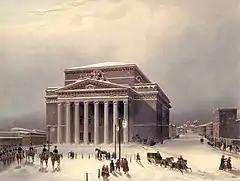
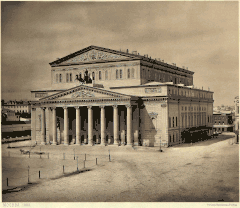


.jpg.webp)
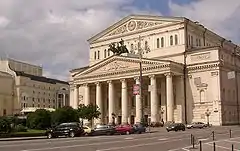
Origins
The company was founded on 28 March [O.S. 17 March] 1776,[7] when Catherine II granted Prince Peter Urusov a licence to organise theatrical performances, balls and other forms of entertainment.[8] Urusov set up the theatre in collaboration with English tightrope walker Michael Maddox.[9] Initially, it held performances in a private home, but it acquired the Petrovka Theatre and on 30 December 1780, it began producing plays and operas, thus establishing what would become the Bolshoi Theatre. Fire destroyed the Petrovka Theatre on 8 October 1805, and the New Arbat Imperial Theatre replaced it on 13 April 1808, however it also succumbed to fire during the French invasion of Moscow in 1812.
The first instance of the theatre was built between 1821 and 1824, designed and supervised to completion by architect Joseph Bové based upon an initial competition-winning design created by Petersburg-based Russian architect Andrei Mikhailov that was deemed too costly to complete.[10][11] The new building opened on 18 January 1825 as the Bolshoi Petrovsky Theatre with a performance of the catalan Fernando Sor's ballet, Cendrillon. Initially, it presented only Russian works, but foreign composers entered the repertoire around 1840.[12]
Renovations in the 19th century
In 1843 a large-scale reconstruction of the a fire in 1853 caused extensive damage and so a further reconstruction was carried out, by Alberto Cavos, son of the opera composer Catterino Cavos.
20th century
On 7 December 1919 the house was renamed the State Academic Bolshoi Theatre. Only a few days later, however, on 12 December, there was an unsuccessful attempt to shut the institution entirely. Beethoven Hall opened on 18 February 1921. Ivan Rerberg directed further reconstruction of the theatre between 1921 and 1923. A bomb damaged the structure during World War II, but this was repaired.
New stage of 2002
A new stage for the Bolshoi Theatre, called the New Stage, went into service on 29 November 2002, constructed to the left of the theatre's historic main stage. Together with auxiliary buildings — a restored 17th-century building, two rehearsal halls, and artists' recreation rooms — it forms a single theatre complex, the Bolshoi Theatre of Russia. The new building is on a natural hill which it shared, until recently, blocks of old houses with communal apartments.[13]
Major rebuilding and renovation (2005–2011)
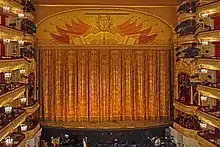
From July 2005 to October 2011 the theatre was closed for restoration. The building, whose architecture combines three different styles, was damaged and a quick renovation seemed to be necessary.
Repairs were initially estimated at 15 billion rubles ($610 million) but engineers found that more than 75% of the structure was unstable,[14] According to The Moscow Times, the true cost may have been double that,[5] and Der Spiegel quotes a figure of $1.1 billion.[6] The rebuilding and renovation was funded entirely by the federal government.[15]
During the long period of reconstruction, the company continued to mount productions, with performances held on the New Stage and on the stage of the Great Kremlin Palace.
The renovation included restoring acoustics to the original quality (which had been lost during the Soviet Era), as well as restoring the original Imperial decor of the Bolshoi.[4][16] Finally, on 28 October 2011, the Bolshoi Theatre re-opened with a concert featuring international artists and the ballet and opera companies.[4] The first staged opera, Ruslan and Lyudmila, followed soon after.
Notable premieres
The Bolshoi has been the site of many historic premieres, including:
- Tchaikovsky's The Voyevoda and Mazeppa
- Modest Mussorgsky's one version of Boris Godunov was given on 16 December 1888.
- Rachmaninoff's Aleko and Francesca da Rimini
- Nikolai Rimsky-Korsakov's opera The Maid of Pskov, with Feodor Chaliapin singing the role of Ivan the Terrible
- Dmitri Shostakovich's opera Lady Macbeth of the Mtsensk District in 1935.
Other notable facts
- The first symphonic concert by the Bolshoi Orchestra took place at the Bolshoi Theatre on 4 May 1919, conducted by Serge Koussevitzky
- During the COVID-19 pandemic, at least 34 members of the theatre were infected.[17]
Ballet and opera
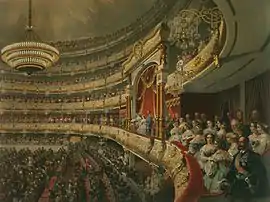

The Bolshoi is a repertory theatre, meaning that it draws from a list of productions, any one of which may be performed on a given evening. Since the dissolution of the Soviet Union, there have been a few attempts to reduce the theatre's traditional dependence on large state subsidies. The Bolshoi has been associated from its beginnings with ballet. Tchaikovsky's ballet Swan Lake premiered at the theatre on 4 March 1877. The chief ballet conductor from 1923 to 1963 was Yuri Fayer.
After the death of Joseph Stalin, the company toured internationally and became an important source of cultural prestige, as well as foreign currency earnings. As a result, the "Bolshoi Ballet" became a well-known name in the West.
However, the Bolshoi suffered from losses through a series of defections of its dancers. The first occurrence was on 23 August 1979, with Alexander Godunov;[18] followed by Leonid Kozlov and Valentina Kozlova on 16 September 1979; and other cases in the following years. Bolshoi continues to tour regularly with opera and ballet productions in the post-Soviet era.[19][20]
Until the mid-1990s, most foreign operas were sung in Russian, but Italian and other languages have been heard more frequently on the Bolshoi stage in recent years.
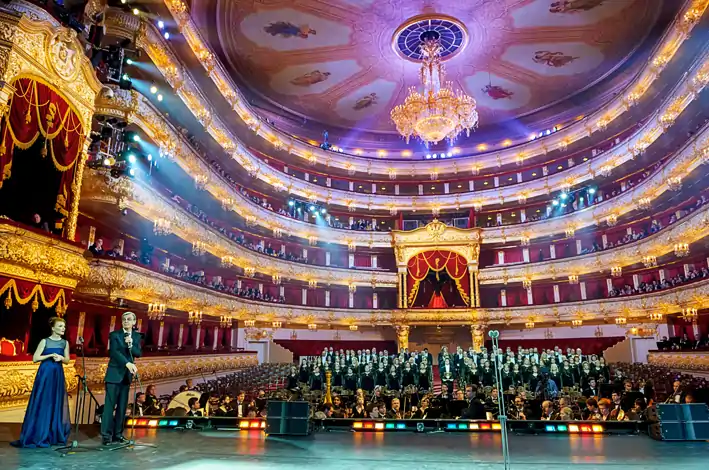
Orchestra

Music director and chief conductor Vassily Sinaisky quit abruptly at the start of December 2013, after a 41-month tenure, citing the need to avoid conflict. General director Vladimir Urin accepted his resignation, and selected Tugan Sokhiev as replacement. Sokhiev's four-year contract, settled on 20 January 2014, and became effective immediately.
Tugan Sokhiev left his position in connection with the 2022 Russian invasion of Ukraine.[21]
Chief conductors and music directors
|
|
|
Cultural status

The Bolshoi Theatre attracts large numbers of tourists. As a result, prices can be much higher than in other Russian theatres.
Controversies
- The rebuilding and renovation cost was $1.1 billion,[6] sixteen times the initial estimate. In 2009 prosecutors alleged the lead contractor was paid three times for the same work.[2]
- Anastasia Volochkova, a former Bolshoi prima ballerina, has said she sees the theatre "as a big brothel" because, she has claimed, ballerinas are invited to parties by theatre administrators and refused roles if they do not accept.[2][6]
- On 17 January 2013, Sergei Filin, the Bolshoi's ballet director, was attacked with sulfuric acid and as a result lost much of his eyesight.[24] A male dancer was later charged with the crime.
- In the area of box office, a theatre insider told the German publication Der Spiegel that tickets are often sold to mafia dealers, who in turn sell them on the black market for double the face value.[6]
- Performance quality has been criticized by the former music director Alexander Vedernikov (2001-2009). He has claimed the Bolshoi Theatre was putting "bureaucratic interests before artistic ones."[2]
- July 8, 2017, three days before the premiere, the Bolshoi Theatre called off the premiere of a ballet about legendary dancer Rudolf Nureyev. The Director General Vladimir Urin claimed it was due to the bad quality of the dancing, however the principal dancer Maria Alexandrova claimed it was the first sign of a 'new era' of censorship.[25] It was the first time a show has been pulled in such a way since the collapse of the Soviet Union (where such censorship persisted), sparking rumours about the motivation behind it.[26]
References
- "Mission". Bolshoi Theatre. Retrieved 20 October 2018.
- Elder, Miriam (22 March 2011). "Bolshoi rocked by scandal and intrigue". The Guardian. Manchester. Retrieved 22 May 2017.
- Galayda, A. (2020-02-11). "Why the only Bolshoi Theater school outside Russia is in Brazil". Russia Beyond the Headlines. Retrieved 2020-02-19.
- "Bolshoi Theatre to reopen after major refit", BBC News on bbc.co.uk, 28 October 2011
- Tabakov, Igor (27 October 2011). "Bolshoi Theater to reopen after restoration". The Moscow Times. Retrieved 22 May 2017.
- Beyer, Susanne; Bidder, Benjamin; Pyljow, Wladimir & Schepp, Matthias (30 January 2013). "Jealousy and corruption rumors surround attack on Bolshoi director". Der Spiegel. Retrieved 22 May 2017.
- "In Short". Bolshoi Theatre. Retrieved 20 October 2018.
- "History". Bolshoi Theatre. Retrieved 20 October 2018.
- Andrew Osborn (27 Oct 2011). "The Bolshoi Theatre: a rich history". Daily Telegraph. Archived from the original on 2022-01-12.
- "История Большого театра". www.bolshoi.ru. Retrieved 26 March 2018.
- Brumfield (2 December 2013). Landmarks of Russian Architect. Routledge. ISBN 9781317973249. Retrieved 26 March 2018 – via Google Books.
- "5ka.ru - Искусство и культура -> Музыка и театр России 19 век". 5ka.ru. 2006-06-22. Archived from the original on 2010-11-20. Retrieved 2023-09-14.
- The New Stage of Bolshoi Theatre Archived 2011-07-16 at the Wayback Machine, See You in Moscow
- Van Gelder, Lawrence (4 February 2008). "Saving Bolshoi Theater". The New York Times. Retrieved 22 May 2017.
- Baldwin, Chris (31 January 2008). "Bolshoi to reopen late in 2009 after rescue work". Reuters.
- "The Theatre: Reconstruction". Bolshoi Theatre. Retrieved 22 May 2017.
- "As it happened - Coronavirus: Trump says US will halt funding to WHO".
- "Turmoil on the Tarmac". Time. 3 September 1979. Archived from the original on May 29, 2009.
- "Today in History - September 18". World of Quotes. Archived from the original on 29 November 2017. Retrieved 22 May 2017.
- "Brouhaha at the Bolshoi". Time. 1 October 1979. Archived from the original on October 15, 2010.
- "Pressed on Ukraine war, Bolshoi conductor Tugan Sokhiev resigns", Al Jazeera, 6 March 2022
- Stott, Michael (13 July 2009). "Conductor exits left as Bolshoi Theatre's woes mount". Reuters.
- Ferris-Rotman, Amie (21 September 2010). "New musical director opens Bolshoi's 235th season". Reuters. Archived from the original on 2013-03-29. Retrieved 2011-06-01.
- "Bolshoi boss Sergei Filin leaves hospital for Germany". BBC News. 4 February 2013.
- "Maria Alexandrova Instagram Post". Instagram. 8 July 2017. Archived from the original on 2021-12-26. Retrieved 11 July 2017.
- "Bolshoi Theatre postpones Rudolf Nureyev ballet". BBC News. 11 July 2017. Retrieved 11 July 2017.
Footnotes
- The Bolshoi Kamenny Theatre used to exist in Saint Petersburg. It stood next to the Circus Theatre (rebuilt in 1860 as the Mariinsky Theatre), but was replaced in the 1890s by the present-day building of the St. Petersburg Conservatory. It was at St. Petersburg's Bolshoi that the first great Russian operas, Glinka's A Life for the Tsar and Ruslan and Lyudmila, premiered.
- In a bit of ideological editing, the Bolshoi Theatre appears to be "destroyed" by the device of a split screen in Dziga Vertov's Man with a Movie Camera.
External links
- Official Bolshoi Theatre website (in English)
- Official Bolshoi Theatre webpages YouTube
- Official Bolshoi Theatre webpages Facebook
- Official Bolshoi Theatre webpages VKontakte
- Official Bolshoi Theatre webpages Twitter
- Official Bolshoi Theatre webpages Instagram
- Bolshoi Theatre in Theatrical Russia Annual Dictionary
- For Ballet Lovers Only: Bolshoi dancers of the past and of today in biographies and photos
- Chief Conductors Archived 2009-02-21 at the Wayback Machine
- Bolshoi Theatre School in Brazil website
- Bolshoi Delights Cuba Audience Photo Feature, Havana Times, Feb 15, 2010
- Reconstruction of Bolshoi Theatre, Pictures
- The New Stage of Bolshoi Theatre, Pictures
- The Bolshoi Theatre at Google Cultural Institute